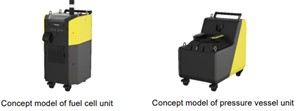News
Teijin develops portable fuel cell and pressure vessel units to promote clean H2 energy use
Teijin Limited announced that it has developed a compact, lightweight and highly portable fuel cell unit and a companion pressure vessel unit that supplies H2 fuel from three lightweight cylinders. The new solution for integrated fuel cell operation and easy fuel supply is expected to help expand the range and scope of fuel cell use.
The units will be used for the first time from June 2023 in a demonstration with Tokyu Construction Co., Ltd., which is participating in a major redevelopment of the Shibuya Station area in Tokyo where the demonstration will take place. After verifying performance during the demonstration, Teijin expects to begin selling commercial versions of the fuel cell and pressure vessel in Japan from around the spring of 2024.
The fuel cell unit is a portable generator that conveniently integrates the equipment necessary for fuel cell operation. Its compact and lightweight design incorporates the new IE-LIFTTM 1T fuel cell developed by British manufacturer Intelligent Energy Limited. A large-capacity battery ensures about one hour of continued operation at the rated output if the H2 supply is temporarily depleted or the fuel cell fails for any reason.
A built-in communication terminal enables the level of remaining H2 as well as the unit's operating status to be monitored remotely via a mobile device, reducing the burden of monitoring critical information and the risk of encountering potential problems. The unit even has an internal system to visualize the amount of CO2 emissions eliminated compared to a fossil-fuel generator. The fuel cell, which measures 450 (W) x 570 (D) x 910 (H) mm and weighs about 60kg, is rated for 700-800W continuous power and 1,500W maximum power.
The new pressure vessel unit is a portable H2-fuel supply device equipped with three Ultressa lightweight, corrosion-resistant composite pressure-cylinders developed Concept model of fuel cell unit Concept model of pressure vessel unit by Teijin Engineering Limited, a subsidiary of Teijin. In addition to reducing the overall weight when transporting H2 fuel under high pressure, the cylinders feature an inner liner made of seamless gas-tight aluminum alloy wrapped in high-strength fibers in a multilayer structure impregnated with epoxy resin. In the unlikely event of cylinder failure due to overpressure, the liner will begin to leak gas rather than rupture (i.e., a leak before break structure).
Also, a decompression device reliably lowers the pressure with a simple valve operation to supply H2 safely even when a cylinder is at maximum pressure. The unit, which measures 510 (W) x 765 (D) x 814 (H) mm and weighs about 80kg, is also rated for 700-800W continuous power and 1,500W maximum power.
Teijin is contributing to CO2 emissions reduction by helping to expand the use of H2 fuel cells in fields such as construction work. By developing H2 fuel cells and promoting their expanded use, Teijin—a company aiming to support the society of the future—hopes to help Japan reduce its CO2 emissions and achieve its targets under the United Nations’ Sustainable Development Goals.
Fuel cells powered by H2, a next-generation energy source, are quieter than fossil-fuel generators and do not emit unpleasant odors as well as harmful greenhouse gases. Current fuel cells, which require a generator system combined with a battery and a controller, are relatively large and heavy, so transporting them can be difficult and require the use of heavy machinery. In addition, H2 storage cylinders must be transported and installed at a safe distance from the generator system. Moreover, residual H2 levels must be carefully monitored, which complicates the operation of current fuel cells.


